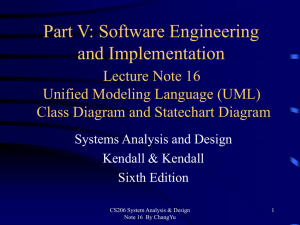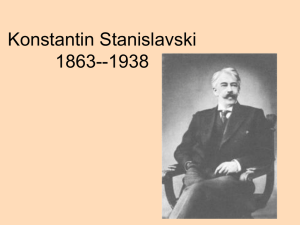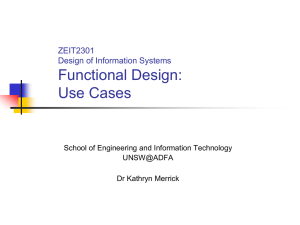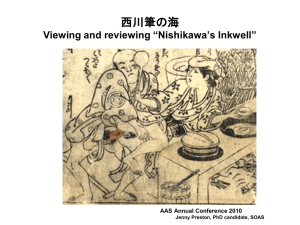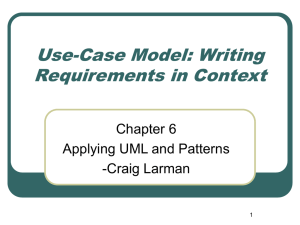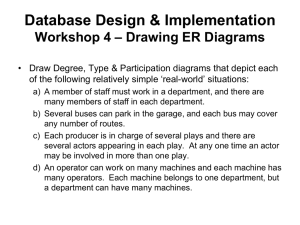CS206-Note15-UseSequence
advertisement
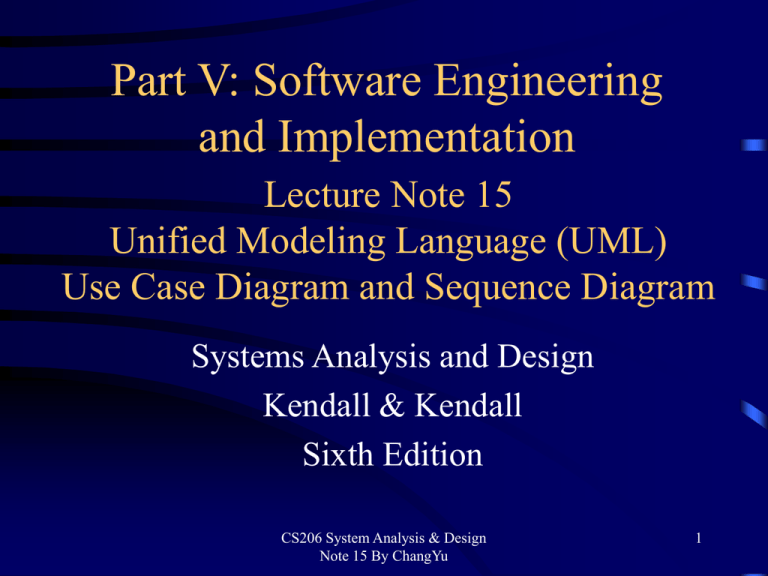
Part V: Software Engineering and Implementation Lecture Note 15 Unified Modeling Language (UML) Use Case Diagram and Sequence Diagram Systems Analysis and Design Kendall & Kendall Sixth Edition CS206 System Analysis & Design Note 15 By ChangYu 1 Major Topics • • • • • • Use Case Diagram Use Case Diagram Syntax The steps for creating a Use Case Diagram Sequence Diagram Sequence Diagram Syntax The steps for creating a Sequence Diagram CS206 System Analysis & Design Note 15 By ChangYu 2 Object Modeling and UML • Systems analysts use the UML to describe objectoriented systems. • The UML uses a set of symbols to represent graphically the various components and relationships within a system. • UML is mainly used to support object-oriented system analysis and to develop object models. • The core of UML is formed by four techniques Use case Diagrams, Sequence Diagrams, Class Diagrams, and StateChart Diagrams. • In this notes, we will introduce how to draw Use Case diagram and Sequence diagram. CS206 System Analysis & Design Note 15 By ChangYu 3 Use Case Diagram • Use cases are the primary drivers for all the UML diagramming techniques. A use case diagram illustrates the main functions of a system and the different kinds of users that interact with it. • The Use Case diagram includes: Actors: which are people or things that derive value from the system, and Use Cases: that represent the functionality of the system. Associations: Draw lines to connect use cases and actors together. System boundary: which represents the system. 4 • The actors and use cases are separated by a system boundary and connected by lines representing associations. • At time, actors are specialized versions of more general actors. Similarly, use cases can extend or include other use cases. • A use case may represent several paths that a user can take while interacting with the system. • Drawn early on in the SDLC, when SA is gathering and defining requirements for the system. 5 Five Steps Processes for Building Use Case Diagram 1. 2. 3. 4. 5. Identify Use Case: The analyst identifies the use cases and creates accompanying documentation, the use case report, to describe each function in detail. Draws the system boundary: Place a box on the use case diagram to represent the system. place the system’s name on the top of the box. Adds the use cases to the diagram: Place use cases inside the system boundary corresponding to the number of functions that the system must perform. Identifies the actors: A person or another system that interacts with and derives value from the system. Add Associations: Draw lines to connect use cases and actors together. CS206 System Analysis & Design Note 15 By ChangYu 6 Example: This figure shows a use case diagram for a Doctor’s Office Appointment System. Patients, doctors, and management personnel will use the appointment system to make appointments, record availability, and produce schedule information. 7 Symbols for Use Case Diagram Name Symbol Actor Is a person or system that derives benefit from and is external to the system. Represents a major piece of system functionality. Use Case System Boundary Meaning System Name Represents the scope of the system. CS206 System Analysis & Design Note 15 By ChangYu 8 Use Case Relationships CS206 System Analysis & Design Note 15 By ChangYu 9 Actor • An actor is labeled stick figures. • Similar to an external entity found in DFDs. • A person or another system that interacts with and derives value from the system. • It is not a specific user but a role that a user can play while interacting with the system. • An actor requests the system to perform a function or process. • Example : A data-entry clerk (or a nurse entering patient information) would not be considered an actor because he or she would fall within the scope of the system itself. CS206 System Analysis & Design Note 15 By ChangYu 10 • Sometimes an actor plays a specialized role of a more general type of actor. • Then, a specialized actor (new patient) is placed on the model, shown using a line with a hollow triangle at the end of the more general superclass of actor (patient). • The specialized actor will inherit the behavior of the superclass and extend (延伸) it in some way. CS206 System Analysis & Design Note 15 By ChangYu 11 Example1: A new patient interacts with the system in a way that is somewhat different than for a general patient. CS206 System Analysis & Design Note 15 By ChangYu 12 Example2: This figure shows a use case diagram for Sales System. The specialized actors (customer and salesman ) will inherit the behavior of the more general superclass of actor (Purchaser). Sales System List Product Order Product Purchaser Accept Payment Calculate Commission Customer Salesman CS206 System Analysis & Design Note 15 By ChangYu 13 Use Case • A use case, depicted by an oval in the UML, is a major process performed by the system that benefits an actor in some way. • It is labeled using a descriptive verb-noun phase. • Use case represents a major piece of system functionality. • It describes a sequence of actions that the system performs to achieve an observable result of value to an actor. • One use case will sometimes use the functionality or extend or include the functionality of another use case on the diagram, and these are shown with “include” or “extend” associations. CS206 System Analysis & Design Note 15 By ChangYu 14 Include relationship: • The includes relationships describes the situation in which a use case contains behaviour that is common to more than one use case. • In other words, the common use case is included in the other use cases. • It can be used to separate out a sequence of behavior that us used in many use cases. • It should not be used to create a hierarchical functional decomposition of the system. • A dotted arrow points to the common use case indicates the includes relationship. CS206 System Analysis & Design Note 15 By ChangYu 15 Example1: An example would be a use common Pay Student Fees that is included in Enroll in Course and Arrange Housing, because the both cases students must pay their fees. CS206 System Analysis & Design Note 15 By ChangYu 16 Example 2: This diagram shows the use case for Library System. The students can borrow the books, renew the books and return the books from the library using Library System. Library System Renew the books <<include>> <<include>> Check borrower’s Status Return the books Student <<include>> Borrow the books CS206 System Analysis & Design Note 15 By ChangYu 17 Extent relationship: • The extends relationship describes the situation in which one use case possesses the behavior that allows the new use case to handle a variation (變化) or exception (除外) from the basic use case. • One use case provides additional functionality that may be required in another use case. • There may be multiple ways of extending a use case, which represent variations in the way that actors interact with the use case. • A condition can be placed next to the dependency arrow. • The arrow goes from the extended to the basic use case. CS206 System Analysis & Design Note 15 By ChangYu 18 Example 1: The extended use case Student Health Insurance extends the basic use case Pay Student Fees. Extended Use Case Basic Use Case CS206 System Analysis & Design Note 15 By ChangYu 19 Example2: This figure is a use case for Car Rental System with an “extend” association relationship and an “include” association relationship. Car Rental System Pick Up Car <<extend>> <<include>> Reserve Car Buy Insurance Customer <<include>> Return Car CS206 System Analysis & Design Note 15 By ChangYu Generate Bill 20 Example3: The doctor’s office system has three basic functions: make appointment, produce schedule information, record availability. Assume every time a patient makes an appointment, he or she is asked to confirm contact information and basic patient information to ensure that the system always contains the must up-todate information on its patients. 21 Generalization relationship: • Represents a specialized use case to a more generalized one. • It is represented as an unlabeled hollow arrow, with more general use case being higher than the lower use cases. • Example1: The Make appointment use case has been specialized to include a use case for an OLD patient and a NEW patient. – The Make Old patient appointment use case inherits the functionality of the a Make appointment use case and extends its own functionality with the Make payment arrangements use case. – The Make New patient appointment use case also inherits all of the functionality of generic Make appointment use case and would include any functionality necessary to capture the information needed to insert the new patient into patient database. – A second specialized actor, Old patient and that patient actor is now simply a generalization of the old and new patient actors. 22 Example1: CS206 System Analysis & Design Note 15 By ChangYu 23 System Boundary • When you create a use case diagram, the first step is to identify the system boundary, which is represented by a rectangle. • The use case are enclosed within a system boundary. • System Boundary, which is a box that represents the system and clearly delineates what parts of the diagram are external or internal to it. • The name of the system can appear either inside or on top of the box. CS206 System Analysis & Design Note 15 By ChangYu 24 Association • Use cases are connected to actors through associations. • Show the use cases that the actors interact • A line drawn from an actor to a use case, as relation with no direction. CS206 System Analysis & Design Note 15 By ChangYu 25 Creating a Use Case Diagrams When diagramming a use case, start by asking the users to • List everything the system should do for them. This can be done using interviews, in a joint application design sessions. • Write down who is involved with each use case and the responsibilities or services the use case must provide to actors or other system. • Review the business specifications and identity the actors in the problem domain. • Identify the high-level events and develop the primary use case that describe those events and how the actors initiate them. • Review each primary use case to determine the possible variations of flow through the use case. CS206 System Analysis & Design Note 15 By ChangYu 26 Creating a Use Case Description • The Use Case Description are needed before creating the use case diagram. The use case describes can be a step-up-step breakdown of interaction between actor and system. • There is no standardized use case description format. • Often the use cases are documented using a use case document template predetermined by the organization, which makes the use case easier to read and provides standardized information for each use case in the model. CS206 System Analysis & Design Note 15 By ChangYu 27 The description may include the three main areas. Some of the areas included are optional and may not be used by all organizations. 1. Use case identifiers and initiators. 2. Steps performed. 3. Conditions, assumptions and questions. 1. Preconditions: the condition of the system before the use case may be performed. 2. Postconditions: the state of the system after the use case has finished. 3. Any assumptions made that would affect the method of the use case. 4. Any outstanding (未解决) issues or questions. 5. An optional statement of priority (优先) of the use case. 6. An optional statement of risk involved in creating the use case. 28 Use case identifiers and initiators. Steps performed Conditions, assumptions and questions. 29 Class Work This is a use case example of student enrollment at a university. • The Add Student use case indicate that students could be added in person, using Web, using a touch-tone telephone, or other methods. The Add Student use case includes the Verify Identity use case to verify the identity of the student. • The Purchase Textbook use case extends the Enroll in Class use case, and may part of a system to enroll students in an online course. • The Change Student Information use case allow student to changes their own personal information. Student could not to change grade, outstanding fees and other information. This use case also includes the Verify Identity use case, and in this situation, it means having the student enter a user ID and password before gaining access to the system. • View Student Information allows students to view their personal information, as well as courses and grades. 30 Student Enrollment System CS206 System Analysis & Design Note 15 By ChangYu 31 Sequence Diagram • Sequence Diagram illustrates a succession of interactions between classes or object instances over time. • Sequence Diagrams are often used to illustrate the processing described in use case description. • In practice, sequence diagrams are derived from use case analysis and are used in system design to derive the interactions, relationships and methods of the objects in the system. • Sequence Diagrams are used to show the overall pattern of the activities or interactions in a use case. CS206 System Analysis & Design Note 15 By ChangYu 32 • • • • A dynamic model that shows the explicit sequence of messages that are passed between classes in a defined interaction, and they are very helpful for understanding real-time specifications and for complex scenarios. Generic (一般的) sequence diagram shows all possible scenarios for a use case. A set of instance sequence diagrams depicts a single scenario within the use case. Each use case scenario which is a single executable path through a use case, may create one sequence diagram. 33 Syntax for Sequence Diagram 34 Elements of a Sequence Diagram Actor and Object • • • Actors and objects that participate in the sequence diagram are placed across the top of the diagram using labeled rectangle. The leftmost is the starting object and may an actor, window, dialog box, or other user interface. Classes are not required to place in particular order, but it is nice to organize them in some logical way. 35 Lifeline • A dotted line runs vertically below each class to denote the lifeline of the class instances over time. • Sometimes a class creates a temporary object and in this case an X is placed at the end of the lifeline at the point the object is destroyed. • When objects continue to exist in the system after they are used in the sequence diagram, then the lifeline continues to the bottom of the diagram. CS206 System Analysis & Design Note 15 By ChangYu 36 Focus of Control • A vertical rectangle on the lifeline shows the focus of control when the object is busy doing things. • This thin rectangle box is to show when the classed are sending and receiving messages. • It may split into two or more concurrent (同時發生的) lifelines to show conditionality, whereby each separate track corresponds to a conditional branch in the message flow. • It also may merge together at some subsequent point. CS206 System Analysis & Design Note 15 By ChangYu 37 Message • It is a communication between classes. Horizontal solid line with arrows show messages or signals that are sent between classes. • The arrow on the link shows which way the message is being passed, and any argument values for the message are placed in parentheses next to the message’s name. • The order messages go from the top to the bottom of the page. Therefore, the message located higher on the diagram means the message occur earlier in the sequence. CS206 System Analysis & Design Note 15 By ChangYu 38 Example: Sequence diagram for Make Appointment CS206 System Analysis & Design Note 15 By ChangYu 39 • This example illustrates an instance sequence diagram to reflect classes and messages for the scenario “manage appointment”. • It describes the process by which a patient creates a new appointment, cancels or reschedules an appointment for the doctor’s office appointment system. • The objects in this example are: APatient, aReceptionist, Patients, UnpaidBills, Appointments and anAppt. objectName: a name with colon after it represents an object. :class a colon with a name after it represents a class. ObjectName::class a name, followed by a colon and another name, represents an object in a class. • Patient::List represents that Patients is an instance of the List class that contains individual patient objects. 40 • A dotted line denotes the lifeline of the class instances over time. • LookUpPatient is a message sent from the object aReceptionist to the object Patients, which is a container for the current patients to determine whether the aPatient object is a current patient. • There are times that a message is only sent if a condition is met and the condition is placed between a set of [], e, g. [aPatient Exists] LookUpBills(). Conditions are shown on a sequence diagram which models a specific scenario. CS206 System Analysis & Design Note 15 By ChangYu 41 Six Steps for Creating a Sequence Diagram 1. 2. 3. 4. Set the context. Identify which objects will participate. Set the lifeline for each object. Lay out the messages from the top to bottom of the diagram based on the order in which they are sent. 5. Add the focus of control to each object’s lifeline. 6. Validate the sequence diagram. CS206 System Analysis & Design Note 15 By ChangYu 42 Class Work Apply the concepts at CD Selections Internet Sales System: Step1: Determine the context of the sequence diagram. We will use a scenario from the place order use case ( show on next page) and list the Normal flow of Events that contains the scenario which this sequence diagram will need to describe: CS206 System Analysis & Design Note 15 By ChangYu 44 1. Customer submits a search request to the system. 2. The System provides the Customer a list of recommended CDs. 3. The Customer chooses one of the CDs to find out additional information. 4. The System provides the Customer with basic information and reviews on the CD. 5. The Customer calls the Maintain Order use case. 6. The Customer iterates over 3 through 5 until done shopping. 7. The Customer executes the Checkout use case. 8. The Customer leaves the Web site. CS206 System Analysis & Design Note 15 By ChangYu 45 Step2: • Identify the objects that participate in the sequence being modeled. • The objects that will be need to describe this scenario are instances of the Search Request, CD List, CD, Marking Information, Customer, Review, Artist Information, Sample Clip , Shopping Cart classes. We also have an actor , Customer that interacts with the scenario. • To complete this step, you should lay out the objects on the sequence diagram by drawing them, from left to right, across the diagram. CS206 System Analysis & Design Note 15 By ChangYu 46 Step 3: • Set the lifeline for each object. • Draw a vertical dotted line below each of the objects. • Also, an X should be placed at the bottom of the lifelines for aCDL and aSC since they go away at the end of this process. Step 4: • Add the messages to the diagram. CS206 System Analysis & Design Note 15 By ChangYu 47 Step 5: • Add the focus of control to each objects and actor’s lifeline. This is done by drawing a narrow rectangle box over the top of the lifelines to represent when the object are sending and receiving messages. Step 6: Lastly, the CD Selections team validated the diagram by ensuring that the diagram accurately and completely represented the underlying process associated with the Place Order use case. CS206 System Analysis & Design Note 15 By ChangYu 48 CS206 System Analysis & Design Note 15 By ChangYu 49

